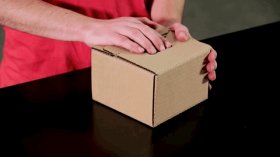Strong cardboard boxes
 While some companies, like Ecovative, are tooling around with highly sustainable alternatives to shipping products around the world, two undergrads have just reinvented the humble cardboard container itself to be more efficient.
While some companies, like Ecovative, are tooling around with highly sustainable alternatives to shipping products around the world, two undergrads have just reinvented the humble cardboard container itself to be more efficient.
Extremely wasteful, environmentally harmful, and hard to put together, the standard cardboard box is as much of a practical necessity as it is a bane to a country dominated by big box retailers, warehouse clubs, and free SuperSaver shipping. Where others looked at the ubiquitous cardboard box and saw a necessary evil, undergraduates Henry Wang and Chris Curro saw a problem that needed to be solved. Their solution? The Rapid Packing Container, a cardboard box for the 21st century that is not only less wasteful than traditional paper boxes, but which can also be put together in seconds and easily reused.
As students at the Albert Nerken School of Engineering at Cooper Union, Wang and Curro started by identifying a few key problems with existing cardboard boxes: they use too much material, they are hard to open, and difficult to pack. The design of the Rapid Packaging Container addresses all of this and more.
Because they are designed to be disposable, cardboard boxes are inherently wasteful. Every year, in fact, over 100 billion cardboard boxes are manufactured in the United States. Some of that cardboard will inevitably be recycled, but not as much as anyone would hope: in 2011, only 37% of all fiber used to make new paper products came from recycled sources. That means that up to 63 billion cardboard boxes a year are made out of newly felled trees.
For the Rapid Packaging Container, Wang and Curro used about 15% to 20% less cardboard than traditional paperboard packaging, while maintaining a maximum 260-pound load strength. The Rapid Packaging Container gets away with using less cardboard thanks to the physical redesign.
Here's how it works. Before they are taped together, most cardboard boxes have two open ends: top and bottom. The bottom is reinforced with twice as much cardboard when folded to make it strong enough to support the content of the box's load weight, even though tape might be the only thing holding it closed. Wang and Curro realized that by designing their Rapid Packaging Container so that the bottom of the box was a single, structurally-sound piece of cardboard, they could eliminate a lot of waste.
This top-loading system also has another practical benefit: it's much easier to fold. All you need to do to fold the Rapid Packaging Container into the right shape, in fact, is take an unfolded box and press it into a custom jig, then close the top and affix it with the built-in adhesive strip . Comparatively, a regular cardboard box needs to be folded manually, and then reinforced with packing tape, which can be a cumbersome and error-filled process.
All of these design flourishes would make the Rapid Packaging Container a dream for many companies. But the end-user design is delightful too. Instead of ripping open a taped-together cardboard box, opening a Rapid Packaging Container is as simple as pushing a tab on the top of the box and having the whole thing unfold itself flat again before your very eyes. Even better, it's fully reversible, meaning that if you receive one in the mail, you can just turn it inside-out for a label free box that you can then send to someone else.



|
The Packaging Wholesalers Open Top Bin Box, 4 x 12 x 4 1/2 Inches, 50 Count (BSBINMT412) Office Product (The Packaging Wholesalers)
|

|
Pratt PRA0802 Recycled Corrugated Cardboard Single Wall Standard Box with C Flute, 18" Length x 14" Width x 8" Height, (Pack of 20) BISS (Pratt Retail Specialties)
|